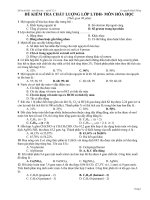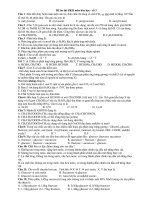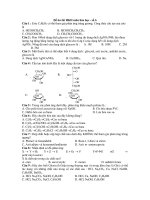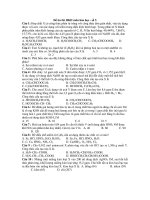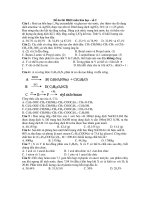Đề ôn thi thử môn hóa (638)
Bạn đang xem bản rút gọn của tài liệu. Xem và tải ngay bản đầy đủ của tài liệu tại đây (124.37 KB, 5 trang )
CHAPTER 44 Overview of Breathing Failure
disorders of muscle (e.g., Duchenne muscular dystrophy, congenital myopathies). The hallmark of these diseases is muscle paresis or paralysis. Hypercapnia is a common feature. Depending
on the extent of weakness, patients will be unable to increase their
work of breathing in the face of lung disease. Importantly, clinical
signs such as tachypnea and accessory muscle usage cannot be
relied on. Abnormal arterial blood gases may be the only indications of worsening breathing failure, especially in patients with
altered sensorium.
Patients with spinal cord lesions develop muscle weakness below the level of injury. For instance, patients with lower cervical
cord injury may have preservation of suprasternal muscle action
but have loss of other accessory muscle function as well as diaphragmatic dysfunction or paresis. These patients will have vigorous suprasternal retractions that expand the lung apices but have
little other movement.
Structural Brain Lesions
Moderate brain injuries are typically associated with hyperventilation, whether the injury is traumatic, infectious, or hypoxicischemic. The hypermetabolic state, lung pathology, and loss
of inhibitory cortical influences probably combine to augment
ventilation. Even when the brain-injured patient does hyperventilate, airway protective reflexes are usually impaired, seizures may
ensue, and subtle progression of the brain lesion may lead to
hypoventilation. Resulting hypoxia exacerbates the brain injury.
Nonstructural Acquired Disorders
Seizures impair breathing in various ways. Apnea or slowing of
respirations, impairment of upper airway protective reflexes, and
poor inspiratory effort are common. Because infants can have
subtle manifestations of seizure, the clinician must have a high
index of suspicion to recognize occult seizures as a cause of hypoventilation. The seizure-induced respiratory depression may be
difficult to distinguish from the brain pathology predisposing to
the seizure (e.g., infection, hemorrhage) as well as the respiratorydepressing effects of anticonvulsant medications.
Respiratory depression by analgesic, sedative, anticonvulsant,
and anesthetic agents is common in the pediatric intensive care
unit. Relative effects on upper airway patency and hypoxic, hypercapnic, and loading responses may be dissociated. Concern regarding respiratory depression does not warrant withholding
analgesia, however, but rather warrants appropriate monitoring.
In fact, the patient experiencing pain may breathe shallowly, exacerbating hypoxia. Sedatives and analgesics that are rapidly cleared
after a single dose may have a more prolonged duration of action
when given repeatedly or continuously. Clearance rates for medications may also vary with systemic disease, immaturity, or genetic factors. Sedation and analgesic-induced respiratory depression may unnecessarily prolong the need for mechanical
ventilation.
Opioid-induced respiratory depression can be reversed with
naloxone. However, in patients with cardiovascular compromise
(e.g., those who have had cardiac surgery), naloxone should be
avoided in the immediate postoperative period because abruptly
eliminating analgesia can provoke dangerous increases in catecholamines. In the patient with multiple drug ingestions, naloxone may induce vomiting without improving airway protective
reflexes, predisposing the patient to aspiration. The benzodiazepine antagonist flumazenil reduces the respiratory depression that
results from taking benzodiazepines, but little pediatric experience
with this agent has been reported. Flumazenil lowers the threshold
497
for seizures and may cause a more hazardous condition than the
initial respiratory depression. Importantly, the duration of action
of antagonists is often shorter than the agent that is depressing
breathing. Close monitoring of the patient is essential, and repeated doses of antagonists may be necessary. In other cases
of drug-induced respiratory depression, mechanical ventilation
provides greater safety than do pharmacologic antagonists, particularly with multifactorial central depression or in severely
ill patients.
Other medications may depress breathing without alteration
of consciousness. For example, prostaglandin E1, which is given
to maintain patency of the ductus arteriosus in infants with congenital heart disease, is frequently associated with respiratory depression. Metabolic alkalosis, which may result from diuretics and
other medications, can promote respiratory depression and may
contribute to prolonged dependence on mechanical ventilation.
When metabolic alkalosis accompanies prolonged recovery from
respiratory failure, correction of the alkalosis may promote ventilator weaning.
Chronic Respiratory Failure
Congenital or long-standing acquired disorders of the central
nervous system may impair respiratory centers, leading to respiratory failure. Acute respiratory insufficiency may accompany
progression of a central lesion. Alternatively, static regulatory
impairment may be revealed by failure to compensate for acute
systemic illness.
Structural Brain Lesions
Recognition of structural brain lesions as the cause of impaired
respiratory regulation is important because some of the lesions are
correctable. Congenital structural neurologic malformations may
manifest as apnea or profound hypoventilation at birth or may be
recognized later. In particular, patients with Chiari malformations
often have central and obstructive sleep apnea.10 Surgical decompression may be associated with improvement even when performed in adults.11 Acquired lesions, such as posterior fossa tumors, may interfere with respiratory regulation before or after
surgical resection.
Nonstructural Congenital Disorders
Some genetic conditions are associated with derangements in
regulation of breathing. Children with congenital central hypoventilation syndrome12 have characteristic mutations in the
PHOX2B gene, which is critical for function of the retrotrapezoid
nucleus.2 These patients may first come to medical attention
because of growth failure, neurodevelopmental disabilities, or
cor pulmonale. Other abnormalities include autonomic dysfunction and cardiovascular instability, occasional association with
Hirschsprung disease, tumors of neural crest origin, and impaired
controls of breathing. The syndrome may be recognized in the
newborn period, later in childhood, and rarely in adults. Sleep
hypoventilation predominates in persons with congenital central
hypoventilation syndrome, although some patients also experience respiratory insufficiency while awake. The disorder is often
fatal without mechanical ventilation. Early mechanical ventilation
may reduce the sequelae and improve long-term neurodevelopmental outcome.
Prader-Willi syndrome is a multigenic disorder initially presenting with hypotonia and then with progressive obesity, growth failure, neurodevelopmental disabilities, reduced ventilatory response
to hypoxia and hypercapnia, sleep hypoventilation, and apnea.13
498
S E C T I O N V Pediatric Critical Care: Pulmonary
Rett syndrome is an X-linked disorder affecting development,
behavior, autonomic and respiratory regulation, and seizures. Occurring only in girls, most cases involve spontaneous mutations,
although occasionally other family members are affected. Abnormalities are often present in the MECP2 gene, although some
patients with characteristic clinical features have other genetic
findings. Multiple phenotypes exist in regard to the respiratory
control disorder, with hyperventilation, hypoventilation while
awake or asleep, and apneustic breathing.14
Many other genetic syndromes with severe neurologic manifestations have impaired upper airway motor function, respiratory
cycle timing, and respiratory effort nonspecifically associated with
their brain disorder. Nongenetic congenital disorders may impair
respiratory controls. For example, children with cerebral palsy occasionally have neurologic deficits of pharyngeal tone, although
the central drive to breathe is usually intact. For this reason, these
patients may paradoxically have improved ventilation with sedation during times of significant respiratory distress caused by
noxious stimuli.
Nonstructural Acquired Chronic Disorders
Some patients with severe chronic respiratory disease have blunted
ventilatory responses to hypoxia, hypercapnia, or respiratory mechanical loads. A concern regarding supplemental oxygen is sometimes raised in the care of patients with acute exacerbations of
chronic respiratory disease. It is sometimes argued that administration of supplemental oxygen causes respiratory failure in patients
with chronic CO2 insensitivity who might depend on hypoxic drive
to breathe. However, the adverse effects of hypoxia are a greater
concern. Because the hypoxic drive to breathe increases substantially only at oxygen tension below 50 mm Hg (see Fig. 44.2A), it
is virtually impossible to maintain stable respiratory stimulation
with mild, “safe” hypoxia without risking episodic life-threatening
episodes. If a patient is so poorly compensated that removal of hypoxic drive results in hypoventilation, then mechanical ventilation
may be the safest management strategy unless end-of-life plans
specifically exclude mechanical ventilation.
Several clinical conditions are commonly associated with hypoventilation. Obesity causes hypoventilation by a complex interaction of factors, including mechanical loads on the respiratory
system, reduction of lung volume, upper airway obstruction, and
impaired respiratory regulation. In obese patients, weight loss often improves hypoventilation.15 Apparently healthy preterm infants may have postanesthetic apnea until the age of 60 weeks’
postconceptional age.16,17 Apneic events occurred within 2 hours
of surgery in 72% of patients, but in the remainder, respiratory
irregularity began as late as 12 hours postoperatively. Both obstructive and central mechanisms of apnea were observed. Continuous monitoring for at least 12 hours after anesthesia is warranted when surgery is required for infants born prematurely who
are still younger than 60 weeks’ postconceptional age. Sleep hypoventilation tends to occur in adults with hypothyroidism and
diabetes mellitus.18 Little information is available regarding the
pediatric patient or the specific role of the endocrine disorder
versus the effect of obesity.
Respiratory Pump Failure
Causes of respiratory pump (breathing muscle) failure are listed in
Table 44.3, along with examples. They may be crudely divided
into direct causes of muscle failure (plegia, paralysis, and tetany)
or muscle failure from exhaustion. Exhaustion may result from
impaired delivery of substrate to the muscles or from increased
TABLE
44.3 Causes of Breathing Muscle Failure
Mechanism
Example
Overwork
Lung dysfunction, airway obstruction
Inadequate substrate
Shock, hypoxemia
Muscle plegia
Hypokalemia
Muscle tetany
Tetanus, hypocalcemia
load due to increased ventilatory demands, or mechanical failure
of the respiratory system, including restrictive or obstructive lung
disease. In most cases, patients progress through a typical phase of
compensation based on the mechanism of the insult, allowing
clinicians to identify and attempt to intervene before frank
breathing failure.
Respiratory Plegia, Paralysis, and Tetany
There are a few conditions in which muscle contraction may be
impaired by dysfunction of the myocyte. Tetrodotoxin (puffer
fish) blocks the fast voltage-gated sodium channel of the muscle
cell, thereby causing paralysis. Hypokalemia may impair muscle
contraction; hypokalemic periodic paralysis has similar effects.
Profound hypophosphatemia can impair the availability of highenergy substrate and is a cause of respiratory failure. Tetanus and
hypocalcemia are capable of causing tetanic contraction that can
impair breathing. All these disorders can result in hypoventilation
and require intervention.
Muscle Exhaustion
When challenged, muscle tension can be augmented by increasing either the frequency of firing or number of motor units being
fired. At low muscle tension, the number of motor units participating in contraction may be increased before frequency is raised.
Recruitment is used to increase work. To achieve an even greater
increase in force, the frequency of firing of individual motor units
may be raised, such that while the number of motor units is held
constant the work of each motor unit is increased.
In pediatric critical care, exhaustion is the most common cause
of failure of the muscles of breathing. The respiratory muscles
may become exhausted when responding to excessive workload.
Airway obstruction (fixed or functional), lung stiffness, thoracic
stiffness (e.g., anasarca), abdominal distension, air trapping, and
inefficient ventilation-perfusion matching (e.g., high ventilationperfusion mismatch, which functionally wastes ventilation) are all
examples. Respiratory muscles may also become exhausted if their
effort is not supported by adequate nutrition, blood supply, and
oxygen delivery. Respiratory distress can be likened to running a
marathon. There can be a “wall” beyond which respiratory muscle
metabolism is not able to sustain further respiratory effort. As
discussed later, the clinical hallmarks of such failure are brief respiratory pauses followed by longer periods of apnea. Without
assistance, after these muscles reach their wall, respiratory arrest
occurs.
Working skeletal muscles rely on a continuous supply of oxygenated blood. Diaphragmatic function can be impaired if blood
flow or oxygenation is reduced. Diaphragmatic muscle cannot
operate at optimal length (force-length relationship) to generate
the appropriate contraction (force-velocity relationship) if energy
demand outstrips energy supply. The combination of suboptimal
CHAPTER 44 Overview of Breathing Failure
force-length and force-velocity relationships causes rapid, shallow
breathing, largely from dysfunction of type IIB fast-twitch glycolic fibers.
Respiratory muscle fatigue also develops during exhaustive
exercise. Prolonged malnutrition has also been shown to affect the
diaphragm’s muscle structure and impair its ability to generate
force. On the other hand, it has been shown that respiratory
muscle training can lessen the development of respiratory muscle
fatigue.19 Training of the diaphragm can increase capillary density,
myoglobin content, mitochondrial enzyme concentration, and
the concentration of glycogen, but persistent mechanical ventilation (particularly during deep sedation or paralysis) decreases
muscle strength by allowing disuse muscle atrophy.
In acute illness, breathing fails if respiratory muscle demand
for blood flow, metabolic substrate, and oxygen delivery outstrips
supply, just as it does in exhaustive exercise.20 The point at which
this occurs is influenced by many factors, including the energy
cost of breathing, duration of contraction per breath, velocity of
contraction, operational length of muscle fibers, energy supply,
efficiency of muscles, and state of muscle training.21
In both shock and hypoxemia, oxygen delivery to respiratory
muscles may prove inadequate to meet demand on a minuteby-minute basis.22 Skeletal muscle may sustain a transient oxygen
debt by unloading oxygen from myoglobin, but such reserve is
limited. Skeletal muscle can also perform anaerobic metabolism
to generate adenosine triphosphate, but only until levels of reducing substances (diphosphopyridine nucleotide) build up to such a
degree that they inhibit the activity of Krebs cycle enzymes. Over
a range of oxygen delivery, metabolic use of oxygen is insensitive
to rates of supply (delivery), but below some threshold, muscle
aerobic metabolism must inevitably be reduced.23
Mitochondrial dysfunction may aggravate deficient muscle
metabolism in sepsis. Impaired oxygen utilization may contribute
to failure of breathing in other mitochondrial crises as well. One
of the indications for intubation and mechanical ventilation in
patients with septic shock is to prevent respiratory arrest from
failure of oxidative metabolism and exhaustion of the muscles of
breathing.
Failure of Mechanics of Breathing
Mechanical factors may pose acute or chronic impediments to
breathing. These factors may be intrinsic or extrinsic to the lungs
and airways. All place a burden on respiratory muscles, increasing
the propensity to become exhausted; some, when severe, cannot
be overcome by any effort (e.g., laryngotracheal foreign body, tension pneumothorax). Exhaustion is the primary mechanism of
breathing failure. Both excessive demand and impaired supply
may come into play; in many children, poor thoracic mechanics
and neurologic impairment contribute to breathing failure from
acute lung disease. Chronic or congenital disorders—such as chest
and spinal deformities, diaphragmatic eventration, prune belly
syndrome (in which abdominal musculature is virtually absent),
and deformities that flatten the diaphragm—may either cause
chronic respiratory insufficiency or contribute to intolerance of
intercurrent processes such as pneumonia.
Typically, lung disease increases the work of breathing. Hypoxia and hypercarbia drive the respiratory muscles toward exhaustion. Efficiency of the respiratory system is impaired by lung
regions of high ventilation-perfusion ratio (dead space ventilation). Because these regions see scant blood flow, they actually
waste ventilation and breathing effort. On the other hand, low
ventilation-perfusion ratio segments cause hypoxemia, which
499
impairs oxygen delivery to tissue and makes circulation inefficient. When oxygen delivery is too low, muscle oxygen utilization
becomes delivery dependent, and muscle work capacity declines.
Other factors—such as the compliance of the infant chest (which
wastes breathing effort), the deformity of kyphoscoliosis (which
makes breathing less efficient), the inefficiency of the infant diaphragm that operates at a wide angle to the chest wall, abdominal
distension (which further widens that angle and opposes descent
of the diaphragm), and the nutritional issues of chronic illness—
accelerate the progression toward respiratory arrest. Superimposed
immaturity, neuromuscular dysfunction, or other comorbid conditions may also exacerbate breathing failure.
As breathing failure worsens, fatigue causes the patient’s respiratory effort to deteriorate. Patients use accessory muscles less,
develop brief respiratory pauses, and progress to apnea followed
by respiratory arrest. Respiratory pauses are a subtle but helpful
warning sign that should be interpreted as impending respiratory
arrest and suggest that respiratory support is indicated. Another
helpful sign is grunting, a low-pitched sound produced by partial
or total closure of the glottis in expiration. Grunting is thought to
augment expiratory lung volume (functional residual capacity
[FRC]) and increase arterial oxygen tension much like positive
end-expiratory pressure.24 Grunting is also a warning of possible
impending arrest in children and adults with respiratory failure,25
though it also often occurs immediately after birth and may
quickly resolve as the neonate successfully navigates transition.
Patients may appear anxious and describe a feeling of air hunger.
Mental status changes ranging from panic to obtundation may
occur. Abrupt respiratory slowing and gasping are harbingers of
respiratory arrest.
Terminal Failure of Respiratory Control and Mechanics
In the advanced stage of respiratory failure, the vigorous respiratory effort of the dyspneic patient may become counterproductive. Agitation increases oxygen consumption and forced respiratory efforts may cause dynamic obstruction of airways. Dynamic
airway obstruction in the dyspneic child may account for rapid
progression of respiratory failure in some cases. As the severely
dyspneic patient decompensates, exhausted efforts may rapidly
give way to periodic breathing and apnea. While this phenomenon is commonly observed in infants with lower respiratory tract
infections26 and pertussis,27 observations in adults with near-fatal
asthma reveal a similar tendency for respiratory arrest to precede
cardiovascular collapse.28 The mechanism of this terminal respiratory depression with severely loaded breathing is not well understood, but it appears to occur in some patients before the development of life-threatening hypoxia and hypercapnia.
Restrictive Versus Obstructive Respiratory
Disease
Mechanical causes of breathing failure can be divided into two
pathophysiologic categories: restrictive and obstructive pulmonary processes. Though both ultimately can lead to breathing
failure, their etiologies, mechanics, and clinical manifestations
often differ.
Restrictive diseases are those that limit lung expansion. These
include processes that (1) fill alveoli with blood, infectious material, edema, or other debris; (2) involve expansion or swelling of
the alveolar interstitium; (3) compress the lung, as with pneumothorax or effusion; or (4) impair excursion of the chest wall or
thoracoabdominal region because of neuromuscular dysfunction,
500
S E C T I O N V Pediatric Critical Care: Pulmonary
skeletal deformity, abdominal distension, ascites, or anasarca.
These processes are characterized by a reduction in vital capacity
and small resting lung volumes, but normal or near-normal airway resistance. The physical examination reflects these processes.
Patients are tachypneic, taking rapid, shallow breaths. Auscultation of the chest may reveal fine inspiratory crepitations (crackles)
or rales as evidence of parenchymal lung disease. Poor excursion
of the chest wall is usually readily appreciated. Retractions (subcostal and intercostal) are common and indicate significant respiratory effort.
Obstructive diseases of the lung are common in childhood and
are characterized by obstruction to flow in airways. In contrast to
restrictive diseases, patients are often less tachypneic relative to
their work of breathing. In fact, with mild obstruction, the respiratory rate is often slower than normal but rises as ventilation
perfusion inequality develops and increases respiratory drive. Often, one phase of respiration is more prolonged than the other
and may have associated adventitial sounds, which can help identify the level of obstruction, as detailed later. Obstructive diseases
may be classified as extrathoracic (above the thoracic inlet) or intrathoracic (below the thoracic inlet). Obstruction may be the
result of occluding material or tissue in airways, reduction in lumen caliber from elevated tone of the smooth muscle of airway
walls or swelling of tissue, weakness of the airway wall causing
collapse and impeding gas flow, or extrinsic compression of airways. In some diseases, several of these processes occur simultaneously. Indeed, secondary obstruction is a common phenomenon.
Obstruction in a proximal airway may cause turbulent gas flow
downstream in distal airways. Turbulent gas flow causes the wall
of the still-developing airway to flutter, further weakening the
wall’s structure and exacerbating overall obstruction.
The hallmark of extrathoracic obstruction is inspiratory noise
(stridor or stertor) and prolonged inspiration. The affected airway
segment lies between the nose and proximal trachea. Inspiratory
stridor is a vibratory sound heard because the reduction of intrathoracic pressure during inspiration narrows the extrathoracic
(subglottic) airway, generating an inspiratory noise. Stertor is a
snoring noise generated in the nasopharynx. Airways with severe
obstruction flutter in both inspiration and exhalation, causing
biphasic stridor or noise heard in both phases of the respiratory
cycle. Other characteristic sounds may help to identify the obstructed airway segment (Table 44.4). In extreme obstruction,
patients may position themselves to maximize airway caliber (remaining upright, leaning slightly forward, and holding the head
in the sniffing position to enhance alignment of the pharynx and
larynx). With severe obstruction, there is little airflow; therefore,
little noise is generated. Loss of noise, despite increased effort, is
an ominous sign indicative of complete obstruction and impending respiratory arrest.
The hallmark of intrathoracic obstruction is a prolonged expiratory phase and adventitial expiratory sounds. In intrathoracic
obstruction, forced expiration compresses soft airways, causing a
musical wheeze. This obstruction may be largely relieved by inspiration, which tends to dilate intrathoracic airways. In severe intrathoracic obstruction, sounds may be heard during both phases of
the respiratory cycle. The classic pediatric disease of intrathoracic
obstruction is asthma. High-pitched wheezes on exhalation are
heard early in the episode. As airway obstruction worsens,
wheezes are heard in inspiration as well. With severe obstruction,
wheezes diminish because there is little gas flow. Tracheobronchomalacia may cause expiratory wheezing and/or expiratory stridor.
With severe collapse of the airway, complete absence of exhalation
TABLE Abnormal Sounds Indicative of Extrathoracic
44.4 Airway Obstruction
Sound
Condition
Hoarseness
Unilateral vocal cord paralysis
Muffled voice
Supraglottic or infraglottic processes,
including epiglottitis
“Hot potato” voice
Oral, retropharyngeal abscess
Cellulitis or connective tissue infection
of the floor of the mouth, also
known as Ludwig angina
“Barking” cough
Laryngotracheobronchitis (croup)
Monotone, hurried sentences
Bilateral vocal cord paresis
may occur. With expiratory obstruction, hyperinflation of the
lung can occur, promoting superimposed restrictive physiology,
which promotes tachypnea that shortens the expiratory time,
promoting a vicious cycle of worsening hyperinflation.
Compensatory Mechanisms in Breathing Failure
A patient may try to compensate for the functional effects of lung
disease. These compensatory mechanisms generally come into
play before there is evidence of breathing failure. Many of the
clinical signs of respiratory distress, discussed previously, are evidence of compensatory mechanisms. Understanding these mechanisms improves one’s recognition of impending failure.
Compensatory Mechanisms in Restrictive Lung Disease
Tachypnea is the patient’s primary compensation for the small
lung volume of restrictive lung disease and is the earliest detectable clinical sign. Additional compensation is achieved by recruitment of accessory muscles. Patients with restrictive disease may
take periodic sigh breaths, which are larger than tidal breaths, to
recruit collapsing units. Compensatory mechanisms also operate
to maximize gas exchange in diseased lungs. Hypoxic pulmonary
vasoconstriction is an important mechanism to improve gas exchange in normal lungs. Hypoxic pulmonary vasoconstriction is a
direct response of the vascular smooth muscle to low Pao2 alveolar
units. The precapillary arteriole of such units constricts in response to low oxygen tension in the adjacent postcapillary venule,
thereby directing blood away from poorly functioning alveoli. In
a lung with patchy disease, the overall effect of the hypoxic pulmonary vasoconstriction response is to shunt blood away from
diseased segments and allow flow to healthier areas. This may,
however, increase pulmonary vascular resistance and oppose right
ventricular ejection. Inhaled nitric oxide (iNO) provides a potential exogenous means to improve ventilation perfusion matching
(by preferentially dilating vessels to ventilated lung segments)
without afterloading the right ventricle, although enduring
benefits with iNO have not been demonstrated.29
Compensatory Mechanisms With Obstructive
Lung Disease
The major compensations in obstructive disease focus on maximizing airflow. As previously stated, patients naturally position
themselves to maximize opening of their airway. If this is the case,
repositioning patients, especially to the supine position, may
CHAPTER 44 Overview of Breathing Failure
worsen airflow. For the infant, carefully monitored prone positioning may aid gas exchange and assist spontaneous breathing.30,31 Control of respiratory rate provides another means of
compensation. In mild obstructive disease, the respiratory rate is
lower than normal. As resistance to airflow rises, work of breathing also rises greatly. To maximize efficiency, the respiratory rate
falls. Longer respiratory cycle times allow longer times for gas
flow. Having said this, the clinician will recognize that many patients
with obstructive lung disease present with tachypnea, not decreased respiratory rates. The causes of tachypnea are (1) ventilation/
perfusion mismatching with hypoxemia, and sometimes hypercarbia, driving the respiratory rate and (2) development of hyperinflation or atelectasis in unventilated lung segments, resulting in
the superimposition of a restrictive process on an obstructive one.
Tachypnea in such patients is counterproductive, greatly increasing the work of breathing and further diminishing gas flow.
respiratory insufficiency. In the infant with severe restrictive disease, recruitment of additional diaphragmatic and accessory
muscles, use of compensatory braking and grunting maneuvers,
and increases in respiratory rate may be insufficient to maintain a
normal FRC. Fatigue comes quickly. Moreover, such work is extremely energy expensive. Infants with chronic respiratory insufficiency can use as much as 50% of their caloric intake for breathing, leaving few calories for growth and other functions, resulting
in failure to thrive.
Infants are also disadvantaged with respect to obstructive lung
disease. In infants and young children, a greater percentage of
total airway resistance is apportioned to large airways than in
adults. Infants are particularly susceptible to nasal obstruction, as
occurs during upper respiratory infection, because the nose may
comprise as much as 50% of total airway resistance. Moreover,
resistance to airflow is proportional to the inverse of the airway
radius to the fourth power:
Special Conditions
Several conditions deserve special note. In these, physical findings
may reflect specific aberrations that generate specific compensatory mechanisms.
Infancy
As has been mentioned elsewhere, young infants are at a mechanical disadvantage for efficient breathing. The configuration of
the infant’s chest wall differs from that of adults. Orientation of
the ribs is more horizontal in infants than in adults, and they
move less during breathing. The chest wall is more compliant and
is composed of more cartilaginous tissue. Strength of intercostal
muscles is less. In the absence of muscular action, FRC is determined by the elastic forces of the lung and the chest wall, which
oppose each other. Accordingly, the infant’s more compliant chest
wall and weaker musculature results in lower FRC. Infants with
lung disease use expiratory braking (grunting), which involves
constriction of pharyngeal muscles and glottis, to increase endexpiratory lung volume. Although this promotes higher FRC, it
imposes a disadvantageous increase in muscular work.
Infant respiratory muscle fibers differ from those of adults. The
infant diaphragm contains a greater proportion of type II fibers,
which are unable to sustain repeated strenuous activity.32 Hence,
the infant’s diaphragm fatigues more quickly than that of the
adult.33 The infant’s diaphragmatic anatomy is also disadvantageous. The reduced appositional area and greater diaphragmatic
angle of the infant causes less lung volume expansion with diaphragmatic contraction. Because pulling the rib cage cephalad
produces less outward chest displacement in the infant than in the
adult, the infant’s tidal volume is, in the aggregate, more dependent on diaphragmatic contraction than that of the adult.
Superimposition of breathing failure on infant respiratory
function exacerbates these mechanical disadvantages. In normal
respiration, the chest wall and abdomen move inward and outward in synchrony. With restrictive lung disease, the respiratory
pattern may be out of phase, called paradoxical breathing. Contraction of the diaphragm pulls the compliant infant chest wall
inward during inspiration and pushes abdominal contents outward. This respiratory pattern is greatly exaggerated by severe restrictive lung disease or inspiratory obstruction. With decreased
lung compliance, the pleural pressure swing is exaggerated, pulling the chest wall farther inward. Prolonged respiration in this
manner can cause inward deformation of the sternum, or acquired pectus excavatum, which is a clinical sign of prolonged
501
R 8 L/ r 4
where h is gas viscosity, L is airway length, and r is the radius of
the airways. Resistance is greater in infants and young children
because of their intrinsically small airways. Further reduction in
airway caliber with obstructive disease (e.g., bronchiolitis) magnifies this problem.
The infant’s airways are also less endowed with cartilage than
are those of the adult and may be subject to flow limitation during
active expiration. The trachea and bronchi may be pathologically
compressed during expiration, causing severe obstruction that is
worsened by expiratory effort. Such regions of severe and pathologic flow limitation (tracheomalacia and bronchomalacia) may
be localized. Similarly, the larynx may be compressed (by atmosphere) during forced inspiration (laryngomalacia) if there is
proximal (supraglottic) obstruction.
Sleep
Sleep modifies breathing, and compensation for respiratory illness
is most likely to fail during sleep.34 In some persons, ventilatory
responses to hypercapnia and hypoxia diminish during sleep.
Sleep-induced reduction in upper airway tone and cough reflexes
worsens the risk of obstruction and aspiration. In infants, the
thorax is compliant. Awake lung volume is maintained by thoracic muscle tone and by breathing at sufficiently high frequencies
that expiration seldom reaches FRC. During sleep, inspiratory
muscle tone diminishes and respiratory rate decreases, with resulting reduction in the infant’s expiratory lung volume. The infant’s
compensation for mechanical loads is compromised during the
rapid eye movement stage of sleep more than during quiet sleep.
Thoracic Dysfunction
Neuromuscular disorders generally result in restrictive lung defects. Coexisting obstructive lung disease can be seen with some
thoracic defects or with scoliosis. Persistent atelectasis and longstanding lung hypoplasia may lead to atrophy and may destroy
supporting airway architecture, resulting in air trapping. Deformities of the rib cage and spinal column result in restriction to
lung expansion, as occurs with isolated scoliosis.35,36 The most
severe of these are classified as “asphyxiating thoracic dystrophies”
in which the chest fails to expand at all during breathing. As with
the other forms of neuromuscular diseases, hypercapnia predominates. Muscle strength may be normal, but abnormal configuration of intrathoracic muscles and diaphragm may make muscle
work inefficient.

